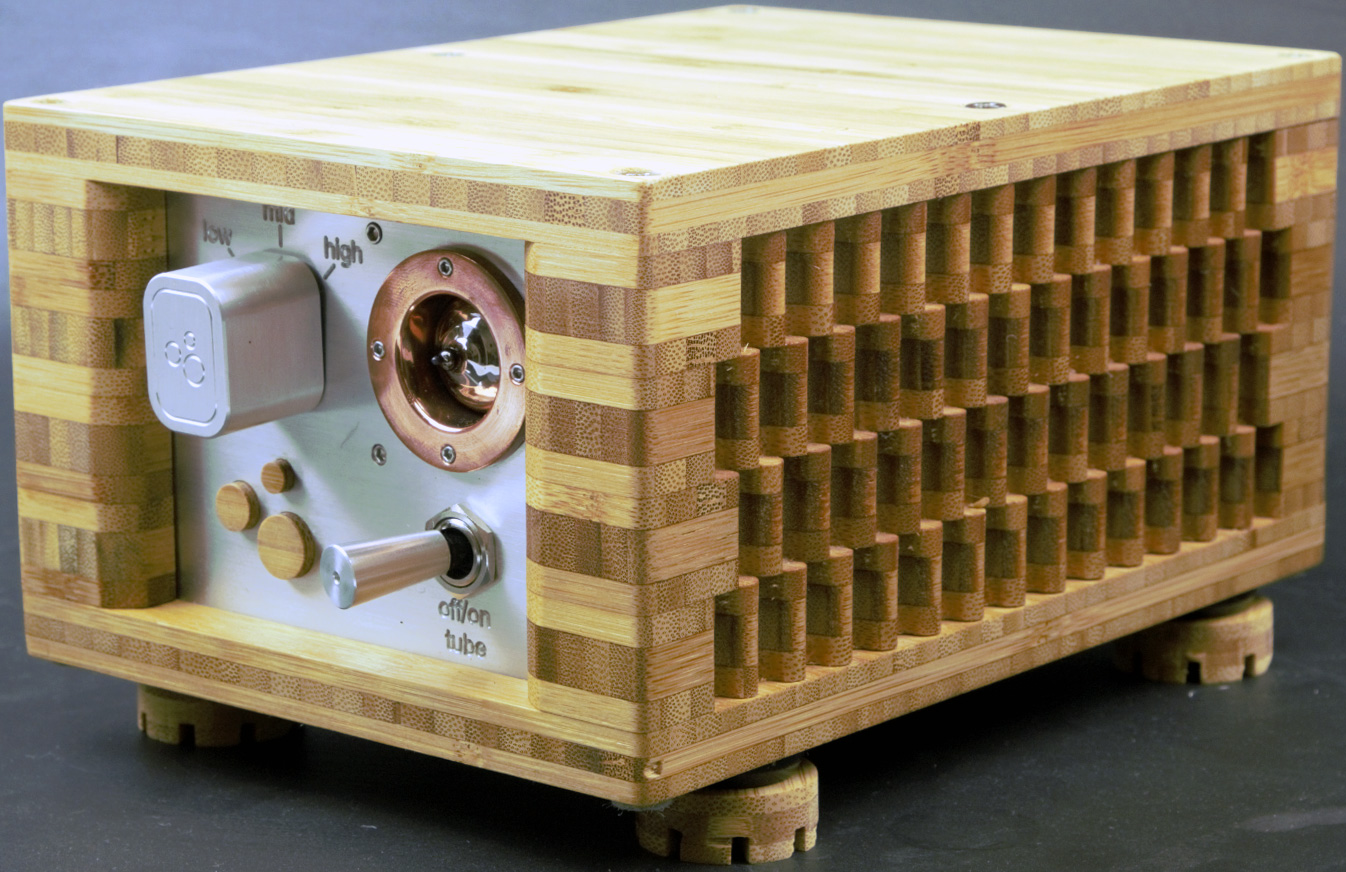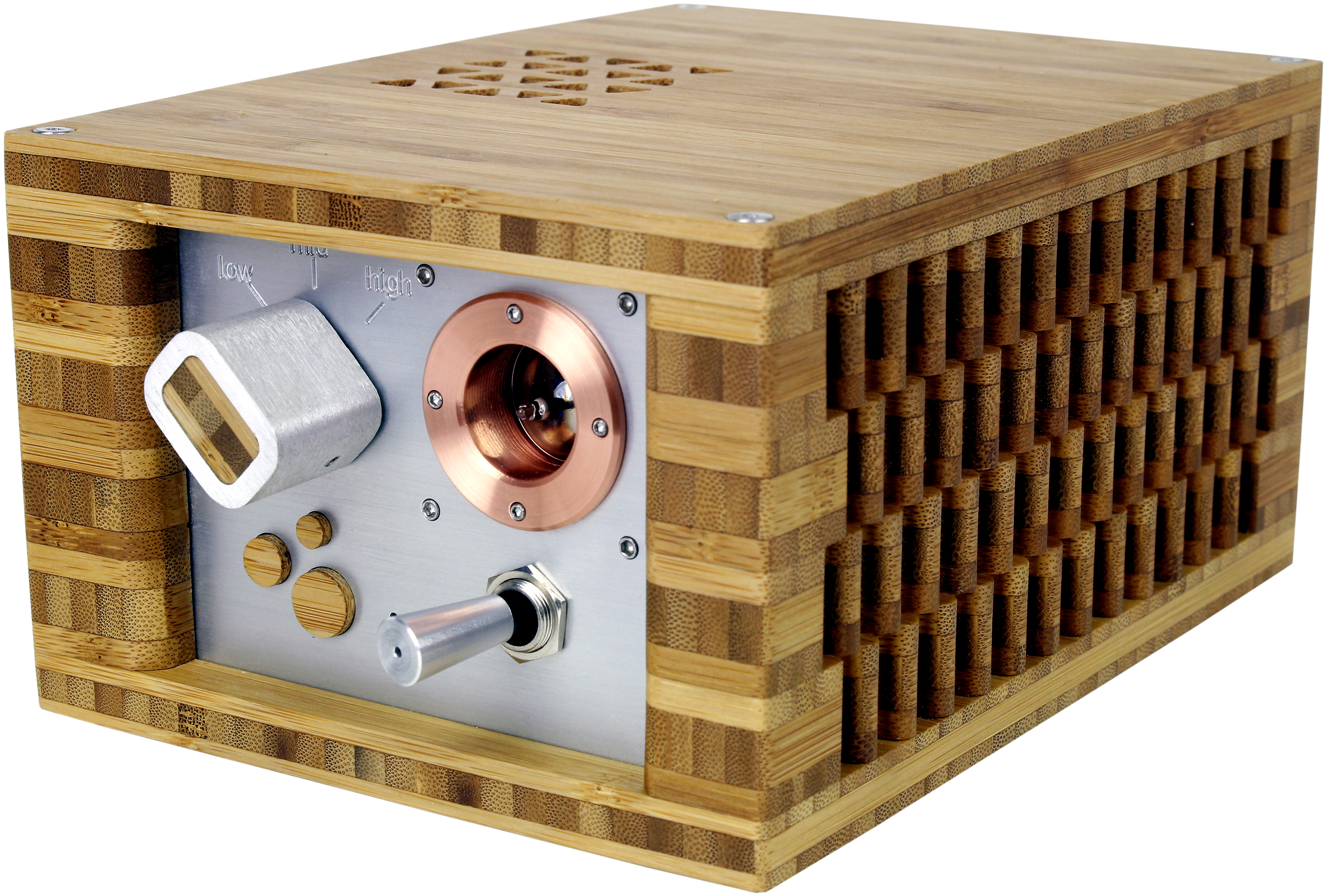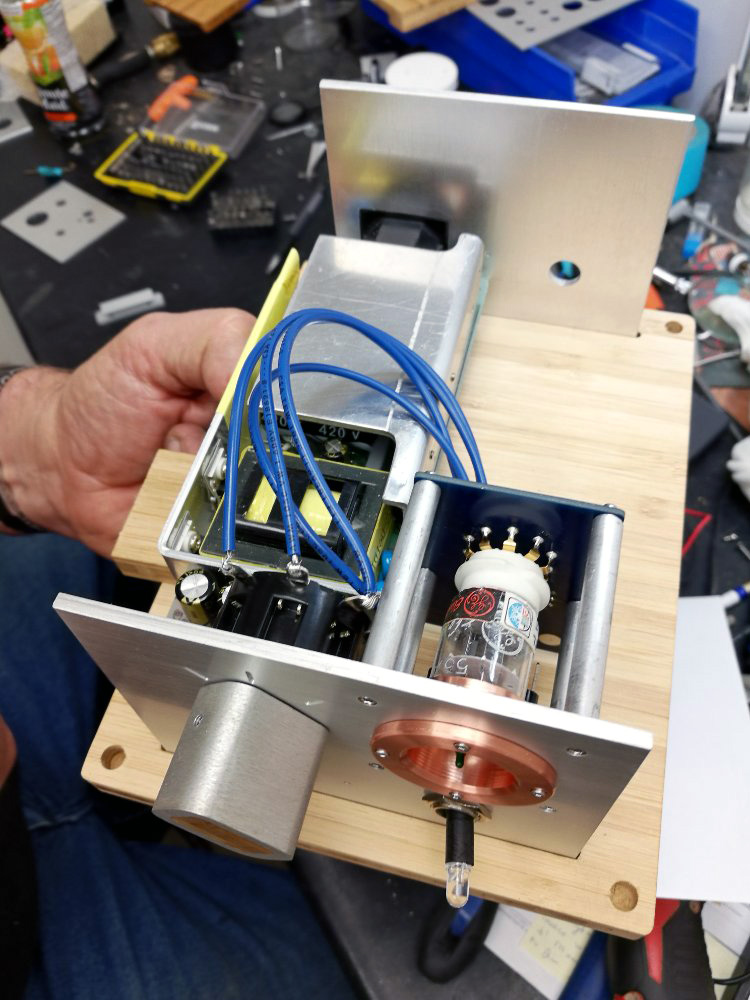Pro sensibility applied to domestic audio
Some pro-oriented companies try to ram truly hideous designs down the consumer’s throat, and fast and sloppy workmanship. Amps that are meant to be schlepped around in trucks and dumped unceremoniously onto a stage are supposed to be just as good as audiophile amps. Junky – and I do mean junky – electronic crossovers are supposed to illuminate the way to superior performance. No, this kind of gear will lead the audiophile to mediocrity. I recall how comparatively tepid the Behringer-based crossover sounded that was replaced by the Legacy Wavelet. The performance differential was so strong that I resolved never to put the Behringer into another system. Legacy was wise to partner with Boehmer Audio and develop the new Legacy Wavelet to accompany cutting edge speaker technology. There are some companies that straddle the pro and domestic world capably, such as Benchmark Audio and Legacy Audio, but they are exceptions.
Just because there is a lot of mediocre product in the pro audio world does not mean that all their methods are poor. There are some wildly efficacious methods that should make domestic audiophiles envious. Typically, a speaker system having a well-executed active crossover is, when compared as closely as possible, superior to a passive crossover. A digital EQ can work wonders to tailor a system to the owner’s delight. These call for more complex systems, the antithesis of the minimalist “wire with gain” ideal of domestic audio. Closer to the minimalist ideal is the methodology employed by Tri-Art in the 5 Open speaker, a technique that is ingeniously clean and effective. That technique is to place an attenuator in the signal path of the full range driver of the speaker. That’s it, just a simple passive attenuator. You would be forgiven for being skeptical, saying, “What’s so great about that?”
Tri-Art did not come up with the idea of attenuating the full range driver. Steve shared that, through his long-term involvement with pro audio, he learned that professional live show sound usually runs the bass at full output, and the output of the upper bass frequencies and above are blended in to suit! No wonder that so many concerts I attended I hated what I considered to be excessive bass output! It stands to reason that such systems will lean heavily toward bass heavy sound when starting with full output of the bass drivers. I rarely go to live amplified performances for that reason. I find my hearing assaulted by those systems, and I do not wish to lose hearing long term for the sake of brief musical experiences. I would rather have my beautiful music in my home daily with good hearing than trade it for problematic hearing and memories of concerts I attended.
But this is very good news for you, the consumer! How so? An example will suffice. I have written previously of my admiration of the PureAudioProject Trio15 (see reviews of the Tang Band, Voxativ and PAP-Horn1 versions) line, especially the PAP-Horn1 model. Though I enthusiastically voiced my approval of the speaker with the two flavors of passive crossovers, I still wish they would emit more bass relative to the horn. The Trio15-Horn1 is an open baffle design similar in many respects to the 5 Open. PureAudioProject has their own active crossover called the PAP-C1, which leans toward the pro way of contouring the drivers, as it is active, with adjustable filters for the bass and full range drivers. By the time this article is published that assessment may be complete. Conversely, the 5 Open uses a passive crossover, but with the addition of a pro audio technique of attenuation to manipulate the output of the full range driver relative to the bass. This is a fine example of minimalist melding of a pro audio method to a domestic speaker.
Attention: Attenuation!
The Open 5 Speaker is a hybrid five-way design employing two identical 15” woofers top and bottom, the upper bass driver operating from 100Hz down and the lower bass driver operating from 50Hz down. The full range 8” crossover point is 100Hz, the soft dome tweeter crossover point is 13,000 Hz, and the Super Tweeter operates above 40,000 Hz. All crossover slopes are first order 6dB. I call this speaker a “hybrid” due to the utilization of an attenuator with the 8” full range driver. Tri-Art did not give specifics in regard to the origin of the drivers. I would anticipate that the drivers are generic, off the shelf versus proprietary or exotic, given the price structure of the speaker. I consider the technical investment into the speaker to be similar to the Kingsound King III Speaker, which also uses “good enough” parts to achieve extremely good sound. Having said that, the Tri-Art crossovers show evidence of conscientious selection of parts, with enormous hand wound transformers and Mundorf EVO oil capacitors.
Just what does the attenuator do for the 8” full range driver, and overall for this speaker? This disarmingly unobtrusive device in one infinitely adjustable control allows for the relative output of the frequencies from the upper bass on up through the treble to be contoured to the output of the bass. With the 5 Open, the bass is on, full bore, to whatever level the volume control of the Pre-Amplifier dictates. That is how typical passive speakers work across the entire frequency range. However, with the attenuator in the signal path of the full range driver, all of those affected frequencies can be brought to bear in relation to the bass as weakly or as strongly as desired, and, consequently, the bass is made to be anywhere from shy to obnoxious, whatever suits the listener.
Let us not fail to recognize, however, that this is not a static adjustment, with one sonic parameter affected by the control. There are several other factors influenced simultaneously by the attenuator, including infinitely adjustable tonal coloration due to the interplay of the full range driver with the bass driver; potential for quick and sure centering of the phantom (center) image within less than ideal speaker positioning; potential for intentional off-center phantom imaging to accommodate hearing issues; and, finally, the potential for tuning the sound via jumper-speaker cables (supplied with the crossover) from the crossover output to each of the three inputs of the speakers — Sub-Bass, Bass, and Full. In other words, this one attenuation control offers more of the flexibility and adjustability of an active crossover than is immediately evident. It is simpler, less costly (the 5 Open can be used with an outboard active crossover and up to six channels of amplification with need for additional cabling), and simpler in terms of system setup.
In summary of the impact of the attenuators, the tonal character of the speaker changes as the attenuator alters the output of the full range drivers. Understandably, if the bass is allowed to predominate, the speaker becomes quite laid back, with a syrupy, warm, rich character. If the mid/treble is allowed to predominate, the speaker carries a more forward, edgy, upper frequency-emphasized character. Thankfully, the output and tonal shifting are not at odds, but complement each other beautifully, such that the speaker sounds surprisingly natural until a truly obtuse setting is achieved. Owners will likely not be disgruntled and conclude that only one thin sliver of the attenuation setting range serves properly. More likely, they will have two or three settings that suit them well and feel the speaker offers multiple personalities to enjoy.
In terms of optimum setup and positioning of a speaker system, it can be very tedious for the audiophile to find just the right location and toe-in to satisfy. It is not uncommon for the owner to spend hours fastidiously charting moves of ¼” or smaller to get the perfect result. With the 5 Open, I was thrilled by how easy it was to lock in the center image by incremental adjustment of the attenuators. Whether due to room anomalies or the hand-built Tri-Art crossovers, there was a variance in the position of the dial for attenuating the full range driver. The owner should pay less attention to the position of the dial of the attenuator than to the sound of the system. To set the attenuators precisely, I used a simple sound test, a recording of the human voice indicating “Left – Right – Center” which can be found with many setup albums/discs. I use one I found on Tidal streaming. To confirm the setting I play specific pieces of music containing powerful center image information. I do not use only recordings of solo voice because the location of the singer can vary due to microphone placement and other variables from recording to recording. One track I use is “Comfortably Numb” by The Scissors Sisters, not because I like the song but because it begins with an on-center pulsing electronic note that disperses to the Left and Right channels. It also gives me an indication of the tonal character of the system. If the pulsing note is too high pitched, I suspect the bass will not be powerful enough to suit me.
The attenuator also allows for quick adjustment upon introduction of a different component, such as a preamp or power amp. There will be a different sonic palate resulting from making system changes, and that result may not always appeal. With a full range traditional speaker if you don’t like it, you are stuck. With the 5 Open’s full range driver having attenuation, you are not stuck; you can revise the ratio of bass to mid/treble and save the new configuration. This is no small matter! In the past I have enthused about the capacity of rolling discrete opamps to contour systems and save them from listener displeasure. In the same way, perhaps on a more fundamental level, the attenuation of the mid/treble can easily save a system, converting it from disappointing to pleasurable.
While the supplied Tri-Art cables (both speaker and crossover/speaker jumpers) are competent, flexible, aesthetically pleasing, and unobtrusive for the typical audiophile, changing any of the short crossover jumpers to the speakers will allow for not just altering the tone but also the definition of the driver. I rather like the richness of the Clarity Cable Organic speaker cables, so a 2-foot pair of them I had on hand for systems using long interconnects with short speaker cables allowed for an upgrade to the Tri-Art jumper speaker cable from the crossover’s “Full” output to the full-range driver. I would like to have also attempted swapping out the jumper speaker cables for the Bass and Sub-bass speaker inputs, but the additional pair of short Clarity speaker cables I had were larger spade terminations and had quite stiff collars that prohibited easy use with this application. The binding posts on the amplifier and crossover are not generously spaced, but did hold up to cinching down with some pressure. I would not trust using a binding post wrench on Tri-Art posts, however. Time only allows me so many avenues to travel in terms of system building. I believe that exchanging those cables would be highly efficacious.
Finally, given the success I had improving the “internal” wiring of the PureAudioProject Trio15 from crossovers to drivers, I would have liked to upgrade the “internal” wiring of the 5 Open as well. However, removing these wires is out of question as they are tightly inserted into the spine of the speaker and the terminations are soldered. If Tri-Art wishes to win the hearts of the audiophile community further, it should consider not soldering driver connections but using push spring locking terminals on the drivers so that owners can potentially upgrade the internal wiring to their choice, yet revert to stock condition at their leisure. In my experiences with the Legacy Audio Whisper DSW Clarity Edition and the Trio15, I aver that would improve the speaker’s performance significantly.
Step aside… I cannot stop playing a new favorite Christmas song, “Little Drummer Boy” by for KING & COUNTRY. The song begins with a bang and escalates from there, reaching a panoply of pounding by an 11- piece drum line! To describe it as powerful hardly captures the experience, but importantly, the dynamic impact and fortitude of the 5 Open was not seriously challenged. I had the full range driver dialed back sufficiently that the big drums pressurized the room easily.
I listened carefully and heard the mallet strikes, the skin flexing, the wave-launch from the drum —it was all there. Did the 5 Open recreate precisely the same energy level as the Legacy Audio Whisper DSW Clarity Edition or the Legacy Valor? No, it did not, but it did a limited imitation of them. Without strain the 5 Open sent tactile vibrations through the carpeting and cement floor of the basement listening room, something few speakers played at reasonable listening levels have been able to do.
One last comment in regard to discussion of the differences between these open baffle designs. Adjusting the relative bass output of the 5 Open is a snap compared to the PureAudioProject Trio15 Horn1. The full range drivers of these speakers are of different technology — a horn versus dynamic — so differing experiences would be expected (see descriptions of these drivers on the manufacturers’ websites for further guidance). However, in terms of setup, the active crossover with the Horn1 is more demanding, requiring a higher degree of education and execution of system build, crossover adjustment and component selection. The 5 Open is fairly a “plug and play” setup. Its setup is not beyond the capability of most audiophiles and, in terms of tuning, it is simple. If you wish to have the benefit of the adjustable output that professionals use but want a hassle-free experience, then you should lean toward the 5 Open as you likely will be frustrated if you feel the speaker system is over your head or requires more time and effort than you wish to invest.
- ← Previous page
- (Page 3 of 4)
- Next page →



